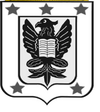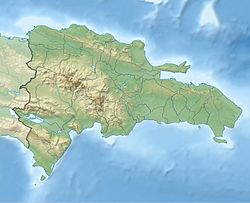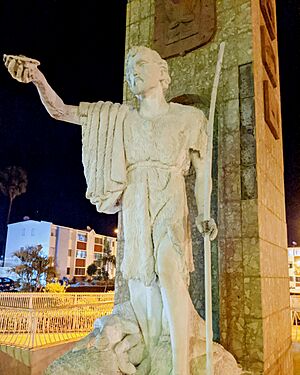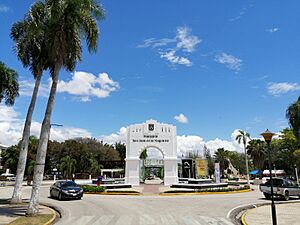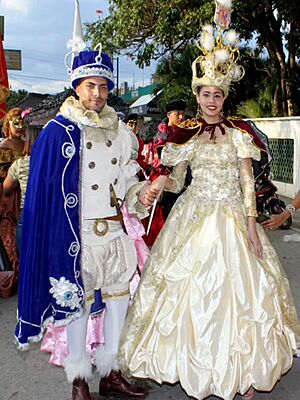San Juan de la Maguana facts for kids
Quick facts for kids
San Juan de la Maguana
|
||
|---|---|---|
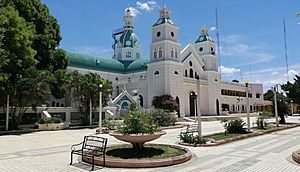
Cathedral of San Juan de la Maguana, Dominican Republic
|
||
|
||
| Country | ||
| Province | San Juan | |
| Founded | 1503; 1733 | |
| Area | ||
| • Total | 1,876.21 km2 (724.41 sq mi) | |
| Elevation | 415 m (1,362 ft) | |
| Population
(2012)
|
||
| • Total | 169,032 | |
| • Density | 90.0923/km2 (233.3379/sq mi) | |
| • Demonym | Sanjuanero(a) | |
| Distance to – Santo Domingo |
200 km |
|
| Municipal Districts | 9 |
|
San Juan de la Maguana is a city and a local government area in the western Dominican Republic. It is the capital of the San Juan province. This city was one of the first places settled on the island.
It was founded in 1503. The name "San Juan de la Maguana" comes from San Juan Bautista and the Taino name for the valley, Maguana. The word "Maguana" means "the first stone" or "the unique stone."
Contents
Where is San Juan de la Maguana?
San Juan de la Maguana is located in the middle of the San Juan Valley. High mountains, called the Central Mountain Range, are to its north and east. The Sierra de Neiba mountains are to the south. Low hills are found to the west.
The San Juan River is the most important river in this area. The city was built on the eastern side of this river.
A Look at San Juan de la Maguana's History
San Juan de la Maguana is one of the oldest cities in the Dominican Republic. It sits in the same valley where the Taino chiefdom of Maguana once was. This area was also home to the historic "Corral of the Indians."
The leader of Maguana was Caonabo. In the local language, his name meant "great lord of the earth." Caonabo led important battles against the Spanish settlers.
A Spanish explorer named Alonso de Ojeda captured Caonabo using a clever trick. Caonabo's town later became the place where San Juan de la Maguana was founded. Rodrigo Mejia Trillo helped establish the city.
Early Settlements and Challenges
Diego Velázquez first founded San Juan de la Maguana in 1503. However, the town did not grow much. By 1574, most people had left. It was abandoned by 1605 as part of the Devastations of Osorio. This was when the Spanish government ordered people to move from some coastal areas.
In the late 1600s, people started to settle in the San Juan valley again. These new settlers came from other parts of the colony and from the Canary Islands. In 1733, the town of San Juan was founded once more. It was built near the original settlement site.
The town grew steadily during the 1700s. A count in 1777 showed 1,851 people lived there. Most of them were free, while some were enslaved. Like many towns then, the main business was raising cattle. The town sold many cattle to the nearby French colony of Saint-Domingue. Only Hincha (now Hinche in Haiti) and El Seibo sold more cattle.
Changing Rulers and Independence
San Juan was briefly ruled by the French. This happened when the Spanish colony was given to France in 1795. This was part of the Peace of Basel agreement. It returned to Spanish rule in 1809 after the Spanish reconquest of Santo Domingo.
In 1820, the president of Haiti, Jean-Pierre Boyer, sent a person named Dézir Dalmassi to San Juan. He gathered support for Haiti to take over the area. In 1821, San Juan became part of the short-lived Republic of Spanish Haiti. This republic was later taken over by the Republic of Haiti (1820–1849) the next year. During this time, the city was known as Saint-Jean de la Maguâna. It was part of Haiti's Ozama department.
The eastern part of Hispaniola declared its independence on February 27, 1844. This new country was called the Dominican Republic. San Juan became part of the Azua province. Haitian forces tried to take back the east in a 12-year war. One of these battles, the Battle of Santomé, happened near San Juan. Dominican forces won, and San Juan remained part of the Dominican Republic.
From its beginning, San Juan grew because of its rich land and good weather. Many different fruits were grown there. Growing sugarcane was also very important for jobs and trade. San Juan first had four "mills" to process sugarcane. The first of these mills was built in the center of town.
What San Juan de la Maguana Produces
The main ways people make a living in San Juan are raising animals and farming. This has been true since the time of the first settlers. The soil is very fertile, and the climate is good for growing crops. Farmers grow grains and beans like beans, rice, corn, peanuts, pigeon peas, and sorghum.
San Juan de la Maguana's Culture
The main festival in San Juan de la Maguana celebrates its patron saint, San Juan Bautista. This happens every year on June 24. San Juan is known for its many different cultural traditions.
One tradition is called "Fiesta de palos." This is a special ritual that happens from time to time. People also make figures that are believed to have special powers. These are sometimes called "Witches of San Juan."
In recent years, evangelical Christianity has become very popular in the community. Many young people are part of this growing religious group. Other Christian groups, like Jehovah's Witnesses and members of the Church of Jesus Christ of Latter-day Saints, are also present.
San Juan de la Maguana's Climate
San Juan de la Maguana is in a valley, which protects it from some weather. It has a relatively dry tropical savanna climate. This means it's hot all year. However, because the city is at a moderate height above sea level, the air is less humid. Mornings are also a bit cooler.
There is a very clear dry season from December to March. During this time, not much rain falls. The rest of the year has a moderate wet season.
| Climate data for San Juan de la Maguana (1961–1990) | |||||||||||||
|---|---|---|---|---|---|---|---|---|---|---|---|---|---|
| Month | Jan | Feb | Mar | Apr | May | Jun | Jul | Aug | Sep | Oct | Nov | Dec | Year |
| Record high °C (°F) | 33.9 (93.0) |
35.5 (95.9) |
36.8 (98.2) |
36.2 (97.2) |
36.2 (97.2) |
37.0 (98.6) |
39.0 (102.2) |
37.5 (99.5) |
37.5 (99.5) |
36.9 (98.4) |
35.0 (95.0) |
33.5 (92.3) |
39.0 (102.2) |
| Mean daily maximum °C (°F) | 29.6 (85.3) |
30.4 (86.7) |
31.4 (88.5) |
31.5 (88.7) |
31.0 (87.8) |
31.8 (89.2) |
32.7 (90.9) |
32.7 (90.9) |
32.2 (90.0) |
31.0 (87.8) |
30.1 (86.2) |
29.6 (85.3) |
31.2 (88.2) |
| Mean daily minimum °C (°F) | 15.3 (59.5) |
16.1 (61.0) |
17.4 (63.3) |
18.9 (66.0) |
19.9 (67.8) |
20.1 (68.2) |
19.6 (67.3) |
19.8 (67.6) |
19.8 (67.6) |
19.5 (67.1) |
18.1 (64.6) |
15.9 (60.6) |
18.4 (65.1) |
| Record low °C (°F) | 8.5 (47.3) |
8.7 (47.7) |
9.4 (48.9) |
11.8 (53.2) |
13.7 (56.7) |
15.6 (60.1) |
13.5 (56.3) |
15.5 (59.9) |
13.5 (56.3) |
14.0 (57.2) |
10.1 (50.2) |
7.2 (45.0) |
7.2 (45.0) |
| Average rainfall mm (inches) | 12.1 (0.48) |
15.4 (0.61) |
31.2 (1.23) |
69.3 (2.73) |
141.5 (5.57) |
90.2 (3.55) |
108.3 (4.26) |
128.2 (5.05) |
148.4 (5.84) |
134.7 (5.30) |
53.1 (2.09) |
18.2 (0.72) |
950.6 (37.43) |
| Average rainy days (≥ 1.0 mm) | 1.5 | 1.8 | 3.1 | 5.9 | 9.7 | 7.9 | 7.7 | 8.9 | 10.3 | 10.8 | 4.8 | 1.5 | 73.9 |
| Average relative humidity (%) | 70.1 | 68.5 | 67.3 | 69.5 | 73.3 | 72.0 | 69.8 | 70.2 | 72.3 | 75.4 | 73.8 | 71.3 | 71.1 |
| Source: NOAA | |||||||||||||
Who Lives in San Juan de la Maguana?
In 2012, a count of the population showed that 169,032 people lived in the municipality. About 60% of these people lived in the city areas. This number includes people from the smaller municipal districts too.
Famous People from San Juan de la Maguana
- Sandy Alcantara – A pitcher in Major League Baseball.
- Jean Segura – A Major League Baseball player.
- Francisco Alberto Caamaño – A former president of the Dominican Republic.
- Danilo Medina – A former president of the Dominican Republic.
- Jose Joaquin Puello – A Dominican revolutionary and military general.
- Manuela Rodríguez Aybar (c. 1790 - 1850) – A poet.
See also
 In Spanish: San Juan (República Dominicana) para niños
In Spanish: San Juan (República Dominicana) para niños


